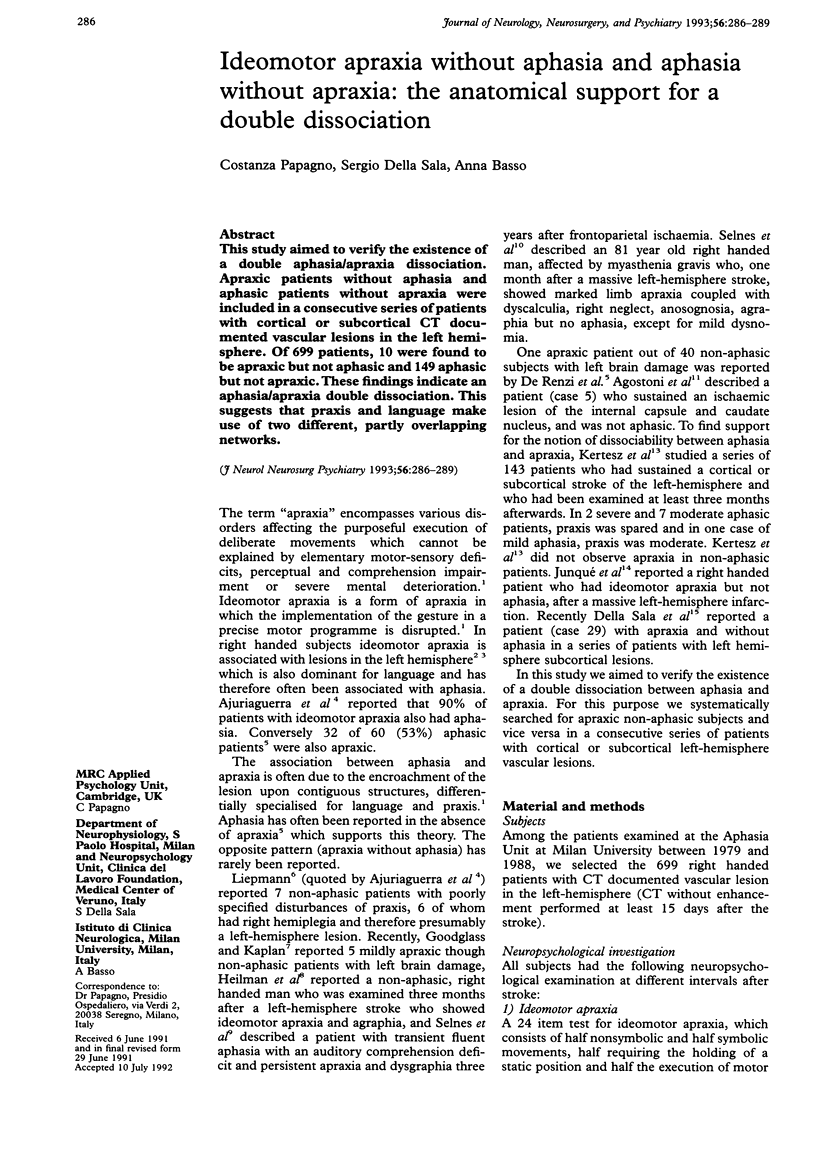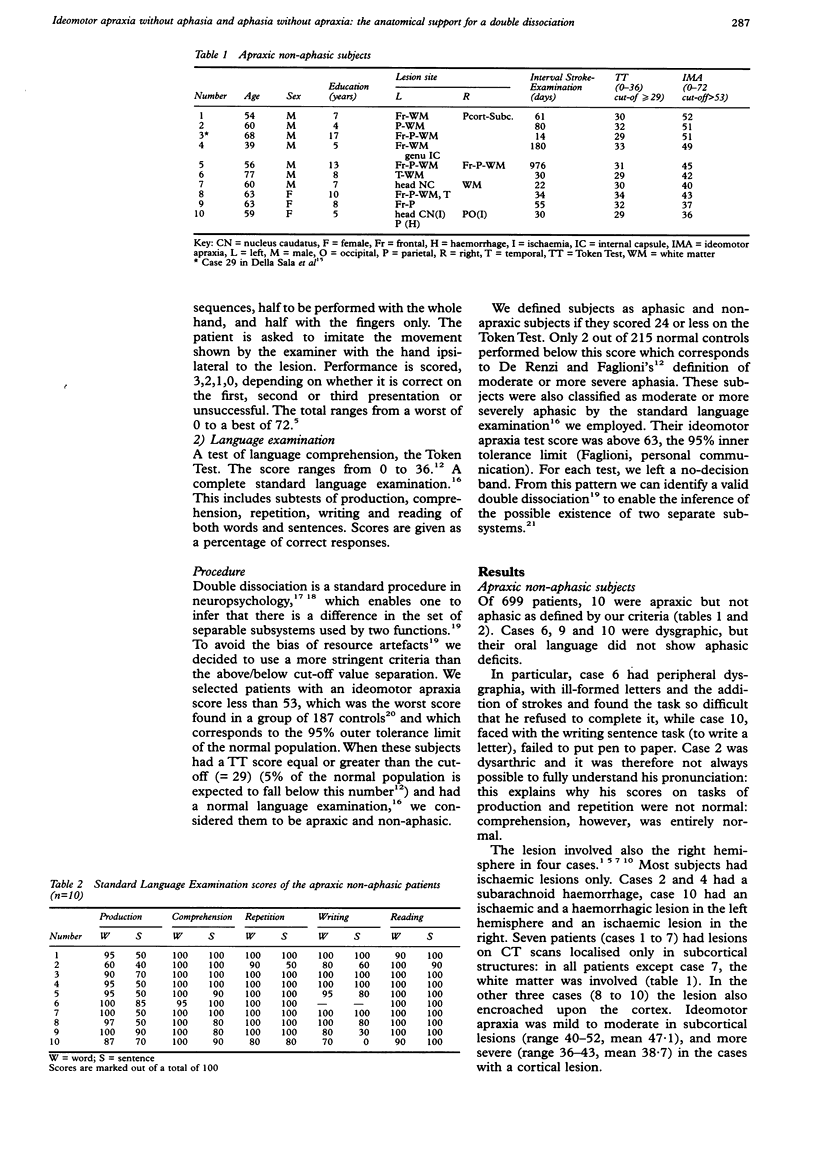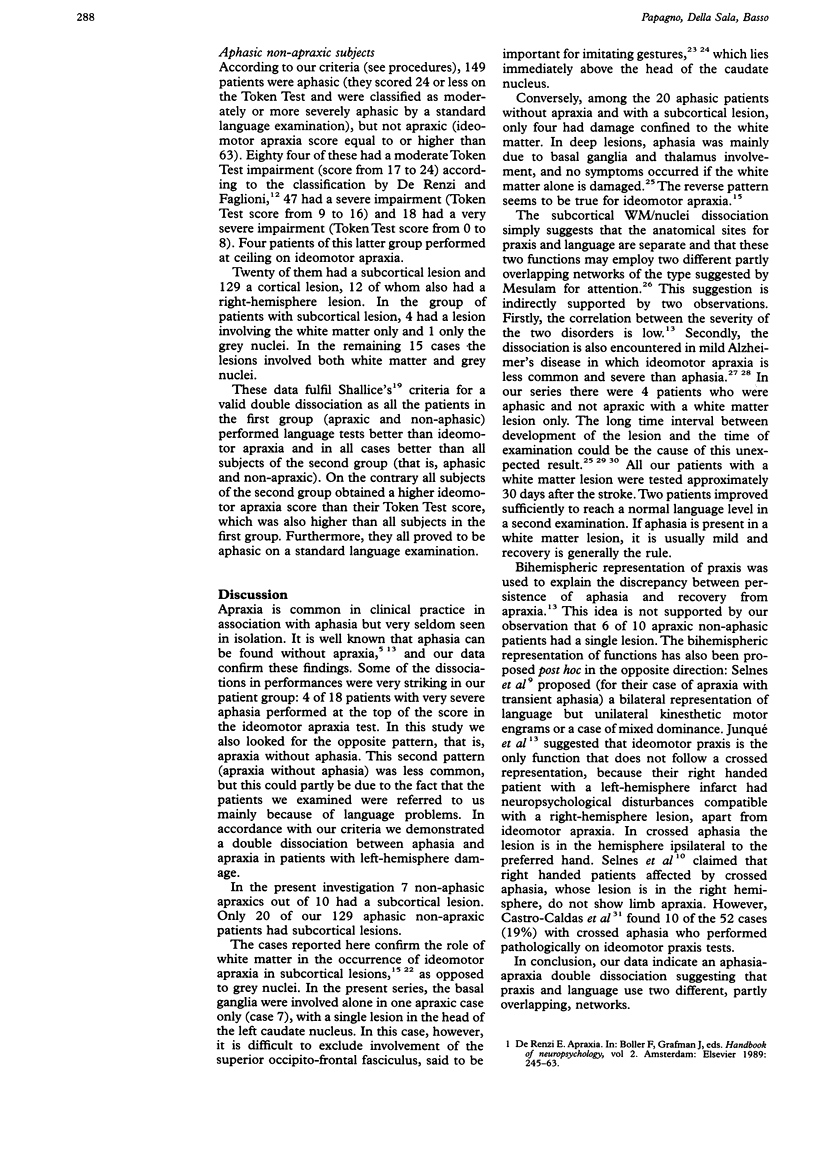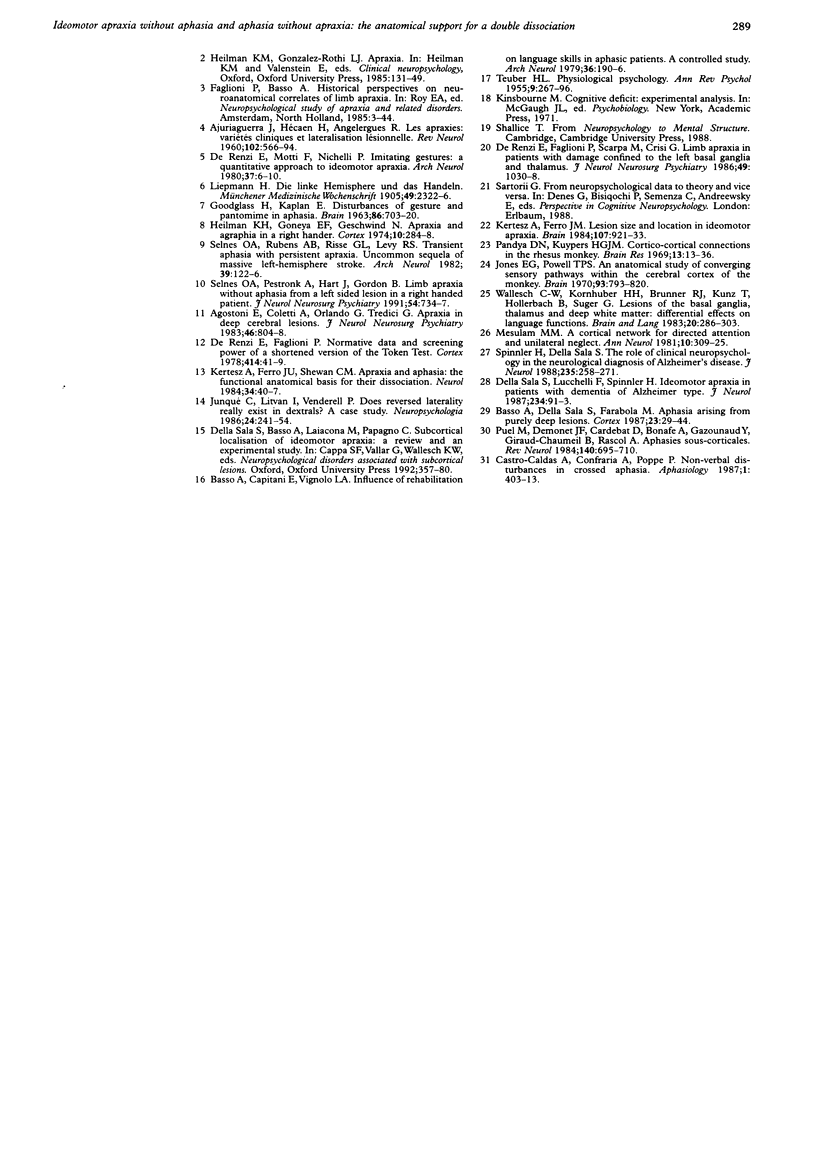Abstract
This study aimed to verify the existence of a double aphasia/apraxia dissociation. Apraxic patients without aphasia and aphasic patients without apraxia were included in a consecutive series of patients with cortical or subcortical CT documented vascular lesions in the left hemisphere. Of 699 patients, 10 were found to be apraxic but not aphasic and 149 aphasic but not apraxic. These findings indicate an aphasia/apraxia double dissociation. This suggests that praxis and language make use of two different, partly overlapping networks.
Full text
PDF



Selected References
These references are in PubMed. This may not be the complete list of references from this article.
- Agostoni E., Coletti A., Orlando G., Tredici G. Apraxia in deep cerebral lesions. J Neurol Neurosurg Psychiatry. 1983 Sep;46(9):804–808. doi: 10.1136/jnnp.46.9.804. [DOI] [PMC free article] [PubMed] [Google Scholar]
- Basso A., Capitani E., Vignolo L. A. Influence of rehabilitation on language skills in aphasic patients. A controlled study. Arch Neurol. 1979 Apr;36(4):190–196. doi: 10.1001/archneur.1979.00500400044005. [DOI] [PubMed] [Google Scholar]
- Basso A., Della Sala S., Farabola M. Aphasia arising from purely deep lesions. Cortex. 1987 Mar;23(1):29–44. doi: 10.1016/s0010-9452(87)80017-5. [DOI] [PubMed] [Google Scholar]
- De Renzi E., Faglioni P. Normative data and screening power of a shortened version of the Token Test. Cortex. 1978 Mar;14(1):41–49. doi: 10.1016/s0010-9452(78)80006-9. [DOI] [PubMed] [Google Scholar]
- De Renzi E., Faglioni P., Scarpa M., Crisi G. Limb apraxia in patients with damage confined to the left basal ganglia and thalamus. J Neurol Neurosurg Psychiatry. 1986 Sep;49(9):1030–1038. doi: 10.1136/jnnp.49.9.1030. [DOI] [PMC free article] [PubMed] [Google Scholar]
- De Renzi E., Motti F., Nichelli P. Imitating gestures. A quantitative approach to ideomotor apraxia. Arch Neurol. 1980 Jan;37(1):6–10. doi: 10.1001/archneur.1980.00500500036003. [DOI] [PubMed] [Google Scholar]
- Della Sala S., Lucchelli F., Spinnler H. Ideomotor apraxia in patients with dementia of Alzheimer type. J Neurol. 1987 Feb;234(2):91–93. doi: 10.1007/BF00314108. [DOI] [PubMed] [Google Scholar]
- GOODGLASS H., KAPLAN E. DISTURBANCE OF GESTURE AND PANTOMIME IN APHASIA. Brain. 1963 Dec;86:703–720. doi: 10.1093/brain/86.4.703. [DOI] [PubMed] [Google Scholar]
- Heilman K. M., Gonyea E. F., Geschwind N. Apraxia and agraphia in a right-hander. Cortex. 1974 Sep;10(3):284–288. doi: 10.1016/s0010-9452(74)80021-3. [DOI] [PubMed] [Google Scholar]
- Jones E. G., Powell T. P. An anatomical study of converging sensory pathways within the cerebral cortex of the monkey. Brain. 1970;93(4):793–820. doi: 10.1093/brain/93.4.793. [DOI] [PubMed] [Google Scholar]
- Junqué C., Litvan I., Vendrell P. Does reversed laterality really exist in dextrals? A case study. Neuropsychologia. 1986;24(2):241–254. doi: 10.1016/0028-3932(86)90056-4. [DOI] [PubMed] [Google Scholar]
- Kertesz A., Ferro J. M. Lesion size and location in ideomotor apraxia. Brain. 1984 Sep;107(Pt 3):921–933. doi: 10.1093/brain/107.3.921. [DOI] [PubMed] [Google Scholar]
- Kertesz A., Ferro J. M., Shewan C. M. Apraxia and aphasia: the functional-anatomical basis for their dissociation. Neurology. 1984 Jan;34(1):40–47. doi: 10.1212/wnl.34.1.40. [DOI] [PubMed] [Google Scholar]
- Mesulam M. M. A cortical network for directed attention and unilateral neglect. Ann Neurol. 1981 Oct;10(4):309–325. doi: 10.1002/ana.410100402. [DOI] [PubMed] [Google Scholar]
- Pandya D. N., Kuypers H. G. Cortico-cortical connections in the rhesus monkey. Brain Res. 1969 Mar;13(1):13–36. doi: 10.1016/0006-8993(69)90141-3. [DOI] [PubMed] [Google Scholar]
- Puel M., Demonet J. F., Cardebat D., Bonafé A., Gazounaud Y., Guiraud-Chaumeil B., Rascol A. Aphasies sous-corticales. Etude neurolinguistique avec scanner X de 25 cas. Rev Neurol (Paris) 1984;140(12):695–710. [PubMed] [Google Scholar]
- Selnes O. A., Rubens A. B., Risse G. L., Levy R. S. Transient aphasia with persistent apraxia: uncommon sequela of massive left-hemisphere stroke. Arch Neurol. 1982 Feb;39(2):122–126. doi: 10.1001/archneur.1982.00510140056015. [DOI] [PubMed] [Google Scholar]
- Spinnler H., Della Sala S. The role of clinical neuropsychology in the neurological diagnosis of Alzheimer's disease. J Neurol. 1988 May;235(5):258–271. doi: 10.1007/BF00314172. [DOI] [PubMed] [Google Scholar]
- Wallesch C. W., Kornhuber H. H., Brunner R. J., Kunz T., Hollerbach B., Suger G. Lesions of the basal ganglia, thalamus, and deep white matter: differential effects on language functions. Brain Lang. 1983 Nov;20(2):286–304. doi: 10.1016/0093-934x(83)90046-9. [DOI] [PubMed] [Google Scholar]


